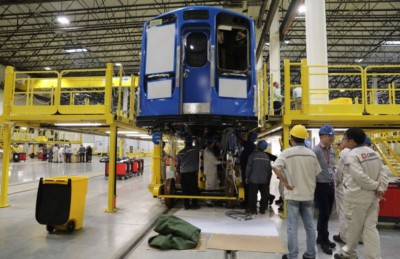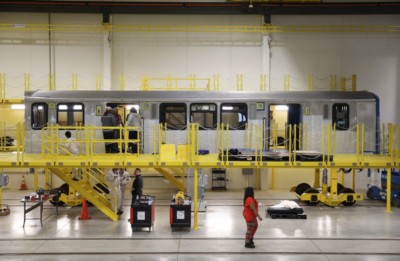Mary Wisniewski | Chicago Tribune
A monumental overhaul of the Chicago Transit Authority’s rail car line has gotten caught up in the nation’s trade war with China.
Tariffs imposed by the Trump administration on Chinese products are driving up the price of the project, which involves replacing about half of the CTA’s fleet. The transit agency and the manufacturer of the new cars disagree about who will bear the additional costs. If the CTA has to pay more, riders could eventually end up footing the bill through higher fares.
Meanwhile, a business advocacy group is raising questions about whether the Chinese manufacturer is using enough domestic parts for the project to qualify for federal funding.

Three years ago, CRRC Sifang America, a subsidiary of a Chinese rail car company, won a $1.3 billion, 10-year contract to produce up to 846 rail cars for the CTA at a manufacturing facility in Hegewisch. CRRC expects the first prototypes to go to the CTA for testing as early as October, and full production could start at the end of next year.
While the cars are being made here, about 15% of the parts, including stainless steel rail car shells, are imported from China and subject to a 25% tariff on imported Chinese goods imposed by the Trump administration, said CRRC spokesman Dave Smolensky.
The CTA has a initial order of 400 cars for $623 million, or $1.58 million per car, with an option of buying 446 more. The tariff adds $59,000 to the price of each rail car.
CTA spokesman Brian Steele said that under the terms of the contract, CRRC must pay for any new costs caused by the tariffs. “We will pay for the price specified by the contract in 2016,” Steele said.
But Smolensky said discussions are underway and “there’s not a definitive answer right now.”
If the U.S. rescinds the tariff before full production starts, the impact of the higher costs could be limited to as few as 10 cars.
Douglas Barry, director of communications at the Washington, D.C.-based US-China Business Council, a nonprofit made of up of U.S. companies that do business with China, said the situation illustrates the unintended consequences of tariffs and why they are a bad idea and bad trade policy.
“It does tend to defeat the purpose of awarding a contract to a low-cost supplier who, through no fault of theirs, turns out not to be low-cost,” Barry said.
In some instances, U.S. buyers of Chinese goods have asked those firms to discount the selling price or share the cost of the tariff. But in most cases, the U.S. buyer absorbs the added costs or passes them along, Barry said.
“[President Donald] Trump’s statement that the Chinese are paying the tariffs is incorrect,” said Phillip Braun, clinical professor of finance at the Kellogg School of Management at Northwestern University. CTA riders could end up paying the extra costs, he said.
There’s also another issue — the CTA is receiving federal funds to help pay for the cars, but to qualify, a majority of components need to be made in the U.S.

The cars need to have a minimum of 60% domestic content to meet requirements under the Buy America Act, and more than 70% of the components will come from U.S. companies, Smolensky said.
However, an advocacy group called the Coalition for a Prosperous America, whose members include domestic manufacturers and the AFL-CIO Industrial Union Council, questions whether CRRC is using enough domestic parts to qualify for the federal funds.
“We don’t believe CTA’s estimate of domestic content is credible,” said Michael Stumo, the coalition’s CEO, in a statement.
The coalition asked the Federal Transit Administration in April to review the CTA’s contract, and the agency is reviewing that request to determine whether an investigation is warranted, according to the agency. Both the CTA and the CRRC disagree with the coalition’s contention.
The 7000 series cars will have a different seating arrangement than the last batch of CTA cars, known as the 5000 series, which have mostly aisle-facing, New York-subway-style seating. The seats proved unpopular with many riders, who did not like getting their feet stepped on while seated, or having their views blocked by standing passengers.
Five prototype rail car shells are already being worked on at the factory on Chicago’s far South Side, where local workers are being trained by visiting Chinese nationals on how to install electrical components, windows, floors, seats and air conditioning. Chicago foremen also have received training in China.
“It’s like a jigsaw puzzle on a very grand scale,” said Brian Vasquez, the plant’s production manager.
The CRRC plans to have a total of 10 prototype cars ready as early as October. Eight will go to the CTA for testing over four seasons, to make sure they hold up in all weather conditions, and CTA riders will see them in use sometime in 2020. They will be delivered in pairs of two — “L” cars are put into pairs during manufacturing and stay mated for life, Vasquez explained.
The cars will be tested first at the plant, running along rails embedded into the concrete floors to testing areas. In one section, they will get blasted by water to make sure they are waterproof while in another, they will run through gates to ensure they can fit properly into the tightest spaces of the CTA rail system, without anything getting knocked off.
Once the year of testing on the CTA is complete, full production of the trains will begin in the 4th quarter of 2020, Smolensky said. By then, employment at the factory should rise from 78 people to 170, and the plant will produce about 10 cars a month, he said.
About a third of the vast factory is taken up by a warehouse which contains parts for the cars — things like air-conditioning units, seats, bolts and cables. The 380,000-square-foot factory also has a lot of room for expansion — CRRC would like to do production of other rail cars, too.
The awarding of the CTA contract to CRRC was not without controversy.
Back in 2016, Bombardier Transportation, a Canadian company that built the last batch of CTA rail cars known as the 5000 series, complained to the CTA that the bidding process had been rigged in favor of the Chinese firm, which promised to bring manufacturing jobs to Chicago. The CTA rejected the appeal.
After the tariffs on Chinese goods were proposed last summer, then-Mayor Rahm Emanuel visited China to make sure the deal wasn’t damaged by the trade dispute.
source: Chicago Tribune